Menu
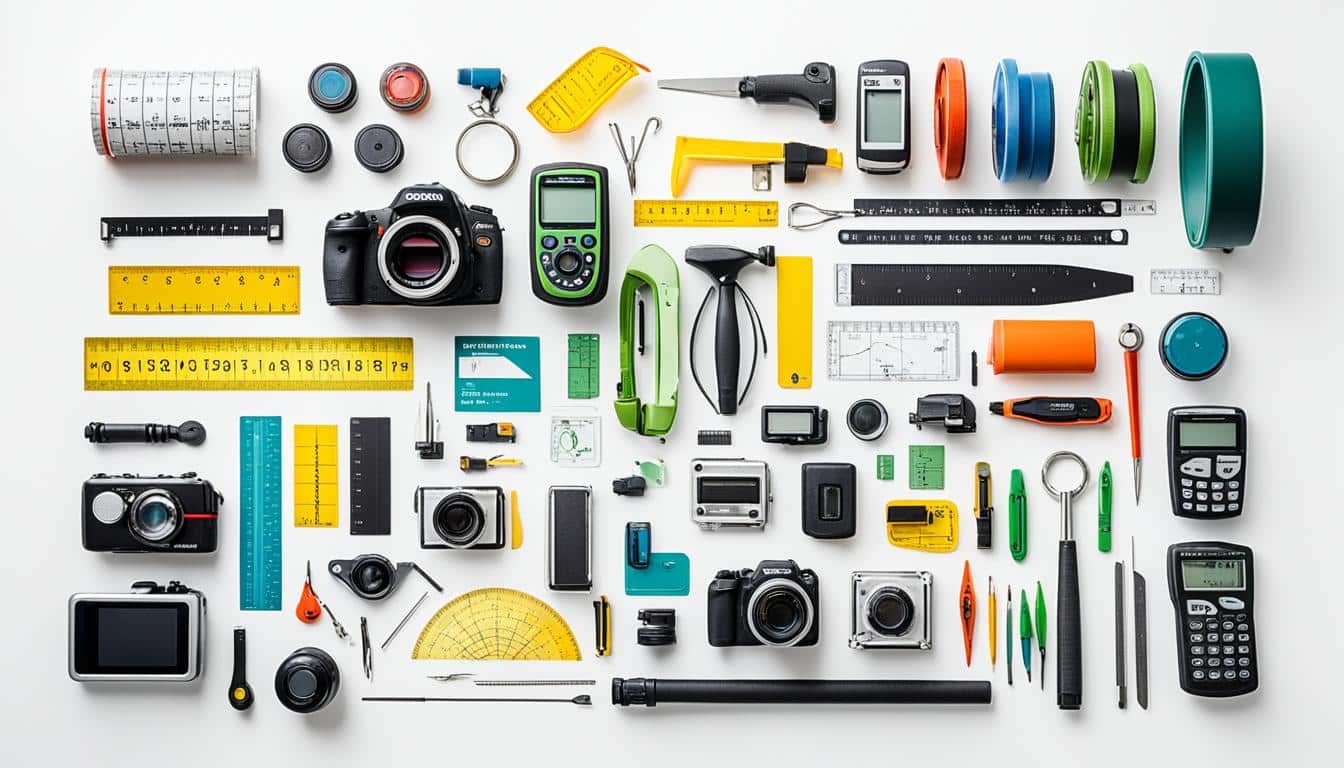
I vividly recall the first time I saw a brightly coloured butterfly in a lush meadow. It reminded me of the beauty and fragility of nature. Right now, our earth is facing bigger and bigger threats. So, it’s crucial to look after the countless life forms on our planet. This guide is critical for anyone who wants to help save our ecosystems. By using the latest tools, we can make sure nature thrives for years to come.
Biodiversity monitoring is crucial for tracking the range and variety of life on Earth. With species disappearing at an alarming pace, it’s more important than ever. Today, nearly 1 million species face the risk of extinction.
Old methods of monitoring biodiversity were slow and expensive. But new ecological monitoring instruments and wildlife surveillance technology have changed everything. Now, high-tech tools like satellites and drones help us watch nature more easily.
Using advanced tools makes collecting data cheaper and faster. It also helps scientists get more detailed information. This is especially useful for those working in parts of the world with fewer resources.
Sadly, wildlife populations are dropping fast, with numbers down by 68% since 1970. This is a big wakeup call for us. Biodiversity monitoring is key to spotting changes in ecosystems. And with the right tools, we can save more species.
In short, biodiversity monitoring is essential for keeping our planet healthy. We can’t protect the environment without knowing what’s going on. High-tech devices help us collect better data for making smart conservation choices.
| Publication Date | May 2016 |
|---|---|
| Authors | Florian A. Werner & Umberto Gallo-Orsi |
| Contributors Acknowledged | 8 |
| Abbreviations Listed | 38 |
| Indicator Categories | 2 |
| Dimensions of Biodiversity | 3 |
| Appendices Included | 3 |
| Selected Monitoring Indicators | Mentioned in Further Resources |
| Monitoring Methods and Software | Recommended in Resources |
| Ecosystem Services Categories | Mentioned |
| Ecosystem-based Adaptation to Climate Change | Referenced |
Monitoring biodiversity is key in protecting nature worldwide. The need is urgent due to quick biodiversity loss. Extinction rates now are thousands of times higher than 60 million years ago. Around 1 million species, from black rhinos to unknown plants, are at high risk of disappearing.
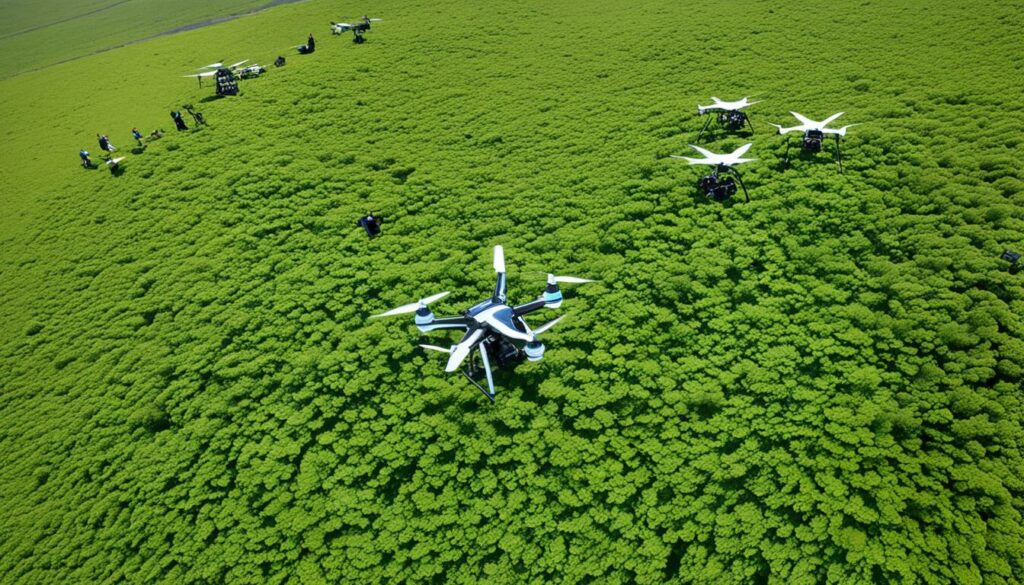
It’s vital to understand where species live to see how ecosystems change. Since 1970, wildlife numbers have dropped by 68% on average. By tracking where species move, we learn about climate change and habitat loss. Drones and remote sensing make this tracking more efficient and cheaper.
A big challenge is evaluating invasive alien species globally. They can harm the environment and economies. Current ways to monitor biodiversity are slow and costly. AI can help gather and analyse data faster. This helps in creating better conservation plans for everyone.
“Effective biodiversity monitoring programs are indispensable for natural resource management, leading to enhanced conservation strategies and necessary actions.”
By bringing together years of understanding, we can make future monitoring efforts better. This will give us early warnings, help us adapt, and watch nature over time.
Keeping an eye on biological invasions is crucial to protect nature. In looking at invasive species, we must watch certain key things. These include where alien species are, what impact they have on ecosystems, and the effects on biodiversity. Having this information helps us manage the risks to nature better and make good policies.
Spotting alien species is key in fighting invasive species. It helps with risk checks and guides decisions on what to do. Even though there isn’t a single way to check invasive species worldwide, watching their spread helps us choose better ways to protect nature.
Knowing the status of alien species is crucial. It tells us if a species is from the area or not. This knowledge helps in planning how to protect nature, especially from new invasions. The latest reports show that species are moving more because of trade. This makes it even more important to track their status.
Alien species can harm biodiversity and ecosystems a lot, often more than turning habitats to other uses. We must gather and look at lots of data to understand these impacts. Knowing this helps us make better policies and choices, aiming to lessen the harm to nature.
By using the Essential Biodiversity Variables (EBVs), we can get better at watching and understanding these invasions. This helps a lot in managing the risks to our nature well. Also, it makes our policy-making smarter and more ready to protect biodiversity.
The key role of Essential Biodiversity Variables (EBVs) is vital in protecting our environment. Over three years, experts defined these EBVs in detail. They include information like how many species there are and where they live, for all types of environments.
Having accurate information about biodiversity is crucial. It helps in setting up goals for protecting nature. Combining technology with the study of nature helps us take better care of the planet.
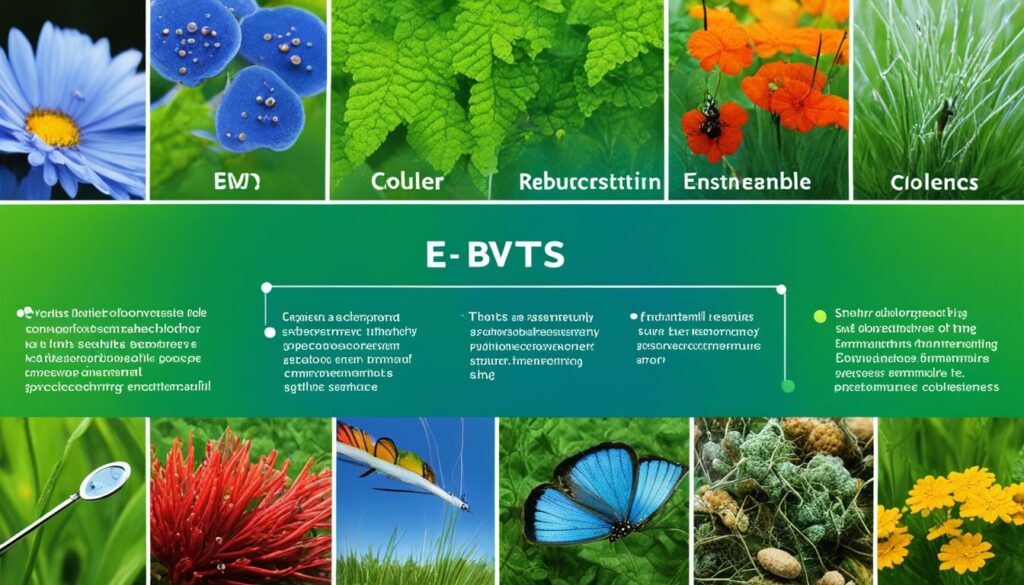
Knowing where species are and how many there are helps with many things. It aids in keeping species safe from going extinct. It also makes monitoring and protecting them more effective.
Putting together different types of information helps in a wide range of areas. But, managing a lot of data can be tough. Challenges include making sure information is accurate and usable for everyone.
Using EBVs in policies makes sure everyone’s working in the same way. It shows a dedication to stopping harmful species from spreading. But, making sure data is available for all is tricky.
To make sharing data easier, experts have come up with 11 steps to follow. These are for studying both land and water. They focus on how to collect the data, including using citizen science, and how to keep it in a way that’s easy for others to use.
| Key Aspects | Details |
|---|---|
| Study Period | 2015 to 2018 |
| Primary EBVs | Species abundance EBV, Species distribution EBV |
| Data Use | Indicators for CBD, SDGs |
| Challenges | Big Data integration, legal interoperability |
| Data Sources | Incidental records, expert synthesis maps |
Biodiversity is being lost faster than ever before in history. Many animals, like black rhinos and orangutans, are close to disappearing forever. This decline makes it vital to have good ways to check on nature’s health.
For a long time, keeping an eye on different species and their homes was hard and expensive. But now, thanks to new technology, this task has become much easier and cheaper. Devices like satellites and drones help scientists get detailed and up-to-date information.
Always, going into nature to study animals and plants up close is important. But, it’s difficult when looking at big areas. This is where things like satellites and special ground sensors come in. They can tell us a lot from far away without as much effort.
New tools like drones and special cameras are changing how we watch over our environment. They help make sure big projects don’t harm nature too much. And they save a lot of money and time. This means making better choices for the planet is easier.
| Tool | Function | Advantages |
|---|---|---|
| Satellite Imaging | Remote ecosystem monitoring | Wide coverage, real-time data |
| Unmanned Aircraft Systems (Drones) | Aerial surveys and data collection | High-resolution data, cost-effective |
| AI-Based Tools | Data analysis and species identification | Accuracy, efficiency |
Galago is a leading name in keeping track of Earth’s wild places. It uses the latest in camera and computer technology to watch animals and their homes closely. Features like 3D models and spotting changes fast are very useful. Galago proves that using drones, cameras, and smart computers for this job saves both time and money.
Using a mix of old and new ways to watch over nature is powerful. It gives us the best chance to save animals and places that need help. And it gives us the answers we need quickly, which is key in protecting nature fast.
In recent years, technology has boosted how we watch over wildlife. It brings new ways to check on our environment. This is very important because a lot of wildlife has vanished in the last half-century. This happened because their homes were destroyed, people hunted them too much, and the climate changed.
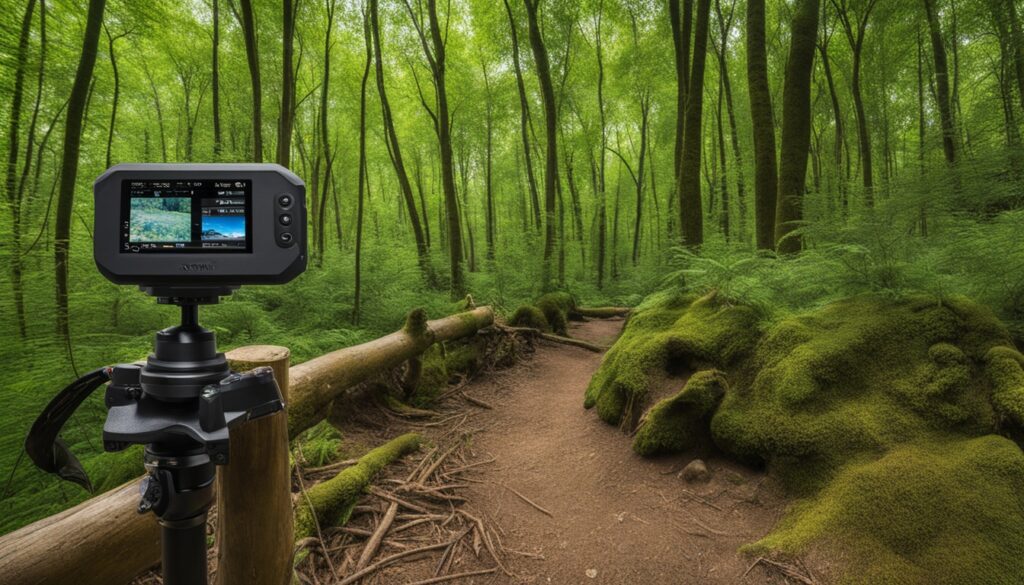
Remote sensing has changed monitoring nature over large areas. It uses tools like satellites and drones. Thanks to this, we found new penguin homes on icy lands in 2020. Also, a system made in the 1970s now tracks about 4,500 birds every month with small, light tags.
Molecular tools are a big step in keeping an eye on wildlife. Especially, DNA barcoding helps spot different species. This is key for understanding and protecting nature. For example, smart technology can tell one primate from another with 94.1% accuracy. In Indonesia, they use face recognition to protect orangutans. These tools make checking on animals faster and more accurate, and less reliant on people.
By using these new tools, we can learn about nature more quickly and accurately. They help conservationists know where animals live and how their homes are changing. This knowledge is vital for making choices that help save our planet’s wildlife.
Devices for checking the environment are key to knowing how healthy areas like soil, air, and water are. Nowadays, using advanced tech, we can spot issues and plan how to protect these areas. This helps make better choices for looking after our environment.
Looking into soil health means studying its life, chemicals, and structure. Older ways were slow and not as good. But now, new tools mean we get lots of info quickly. This helps people who want to look after nature to see how well soil supports life.
Checking air and water helps see if there are things hurting wildlife. Today’s sensors give us info right when we need it. This is a big help in working out plans to stop harm and save different creatures, like those in areas where wildlife numbers have dropped a lot since 1970.
New tech, like drones, has made it easier and cheaper to collect data about nature. Even poorer countries can now join in and help try to look after our world. This is good for everyone who wants to keep the planet safe.
| Device Type | Function | Benefits |
|---|---|---|
| Soil Health Probes | Assess soil biological, chemical, and physical parameters | Improves understanding of soil health and supports life |
| Air Quality Sensors | Measure pollution levels | Aids in quantifying air pollutants and informs mitigation strategies |
| Water Quality Sensors | Detect water contamination | Helps protect aquatic ecosystems by early detection of contaminants |
NatureMetrics is trusted by over 500 companies in 104 countries for checking on wildlife. This shows that using today’s monitoring devices really works. By using these tools, we can help stop the decline of wildlife and protect the environment.
Biodiversity monitoring succeeds by using both scientific and public methods. The tools for this include many ways to collect ecological information. Each way aims to ensure the data is both full and a true picture of the area.
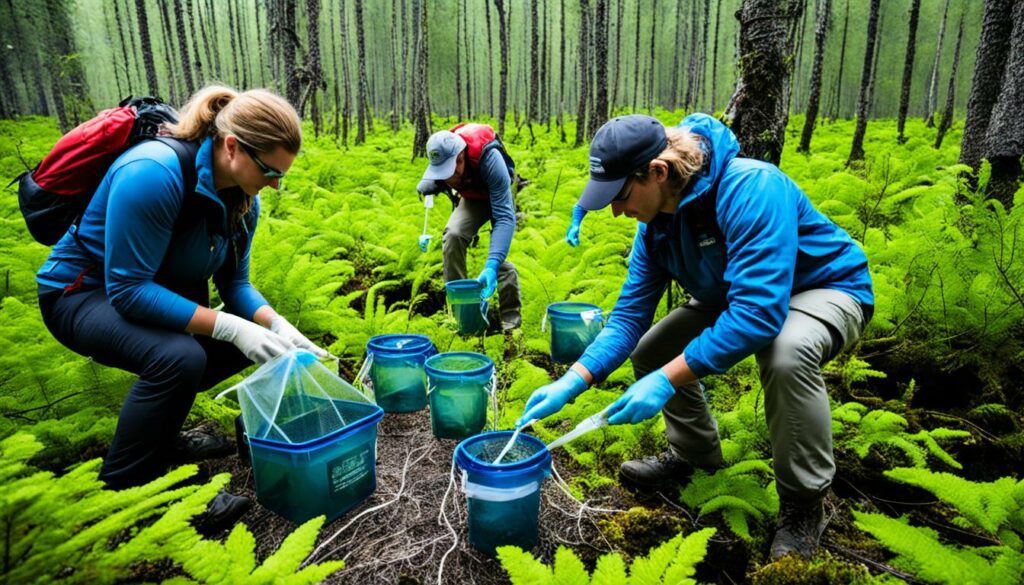
Going out into the field is key to seeing the different life forms. For example, in Biodiversity Surveys, workers note findings at 100 locations along a path. This gives about 3,300 facts for each place. In Quadrat Surveys, thirty-three measuring squares help count small creature types. Reporting is key, like noting sea star numbers and names, in a two-meter strip on each side of the path.
Measuring land height is another important task. It uses tools like laser levelers. Adding to this is the use of Photoplots, which are measured carefully along the paths. These methods are vital to biodiversity studies.
Citizen science has helped greatly by letting more people join in. These non-experts now gather data, increasing what we know. For example, they have been watching places since the ’90s, contributing to long-term data.
Using eDNA is a new way to get the public involved. The method, as shown in the Indian River Lagoon, is good at bringing quick, affordable insights. This approach not only adds to the data but also grows support for protecting nature.
Combining official methods with public help leads to better and wider data. This shared work makes biodiversity studies more accurate. It helps in making smarter choices for saving nature.
The way we collect data for conservation has changed with new technology. Now, tools like automated systems, camera traps, and acoustic monitors help us gather important information. They give us a better look at plant and animal life, as well as the health of our natural spaces.
Automated systems have made a big difference in how we watch the environment. They can keep an eye on things all the time, without us having to be there. This means we get a lot more data, without spending as much time and effort. A good example is NatureMetrics. It helps hundreds of companies in lots of countries keep track of living things.
Camera traps are another cool tech for looking after wildlife. They use cameras that start filming when they sense movement. This lets us see which animals are living in different places, without disturbing them. By using these together with other systems, we get better information faster.
Adding in acoustic monitors helps too, especially for water-loving animals like American bullfrogs. They can pick up frog calls and other sounds. Mixing these tools together helps get a full view of life in an area. It makes the data we collect more complete and accurate.
| Technology | Function | Example |
|---|---|---|
| Automated Recording Systems | Continuous environmental monitoring | NatureMetrics Nature Intelligence Platform |
| Camera Traps | Non-invasive wildlife imaging | Motion-sensitive trail cameras |
| Acoustic Monitors | Sound recording for species detection | Audio moths for bullfrog calls |
These tools change how we protect our world, making it easier for scientists and nature lovers. By using new tech, we can understand and protect the planet better. There’s a lot of hope for the future of nature because of these advancements.
A strong data system is key for keeping an eye on invasions. It has to handle lots of data from checks happening all the time. This system is set up to gather essential information about the invading species.
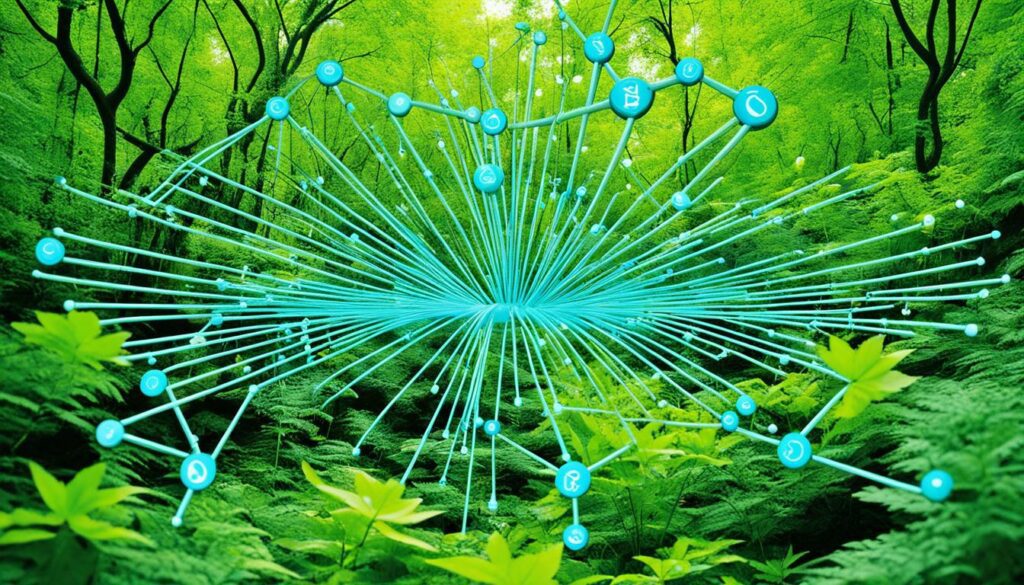
To watch out for invasions, we need good systems for gathering and sorting data. These systems have to keep track of which alien species are where and what they are doing. It’s important to update whether these species are present or not every 1 to 5 years. And we should check if they belong there or not every 10 years.
The IUCN Environmental Impact Classification for Alien Taxa is a big help in figuring out how bad invasive species are. But, one main issue is that data quality differs a lot between countries. We need to work on making sure the methods we use are fair and reliable everywhere.
Using the same methods is crucial. It makes the data consistent and easy to compare. This way, we can put together data from different places and times in one place. Doing this helps us focus our efforts over time on dealing with the worst invaders.
It’s not just the environment that suffers from invasions; they cost a lot of money too. By getting the public and experts to use technology to spot invasive species early, we can save money and nature. This shows how important everyone’s help is in dealing with invasive species.
| Essential Variable | Update Frequency | Purpose |
|---|---|---|
| Alien Species Occurrence | Every 1 to 5 years | Tracking presence or absence |
| Alien Species Status | Every 10 years | Determining indigenous or non-native status |
| Impact Classification | Every 5 to 10 years | Assessing impact on biodiversity and ecosystems |
Bringing biodiversity metrics together with soil health checks gives a full look at ecosystem work and resilience. It’s key to dovetail *biodiversity and soil health integration*. Doing this ensures future friendly ecosystem care. Making smart use of *ecological monitoring tools* helps us watch how things change. Then, we can make plans that fit with green policies.
The Biodiversity & Soil Health Metrics Tool helps pick important parts for checking nature. It has looked at 26 ways to measure biodiversity. These were checked to fit different aims. Parts like where animals live, types of animals, and how places are connected are vital for all green plans. The tool’s way of working is clear. It gives strong facts for looking at whole ecosystems. This means we can keep an eye and adjust to nature changes.
| Indicator Type | Priority Level | Policy Integration |
|---|---|---|
| Habitat Indicators | High | All Policy Areas |
| Species Indicators | Moderate to High | All Policy Areas |
| Connectivity Indicators | High | All Policy Sectors |
| Ecosystem Health Measures | High | Detailed and Larger Project Planning |
Good *monitoring protocol planning* is vital for biodiversity and soil health success. It means choosing what to measure at many levels. This fits the goals of each project. The Biodiversity & Soil Health Metrics Tool offers help. It lets us measure ecosystem parts well. And don’t forget, keeping an eye long-term is key. It helps us see how biodiversity changes. Then we can adapt as the environment does.
Measuring farm biodiversity might need ways that can change but stay on target. Yet, for things like selling biodiversity benefits, we need lots of figures. This shows how we keep making our tools better. We do this by listening to how they work over time. So, they stay useful and on point.
A method that’s easy to understand is vital when counting biodiversity. Plus, we listen to stakeholders. They want us to see how nature helps us beyond just counting species. This makes *biodiversity and soil health integration* essential for our planet’s future.
Countries worldwide are working together to keep an eye on our biodiversity. By sharing knowledge through national biodiversity strategy networks, they take strong steps against threats to our natural world.
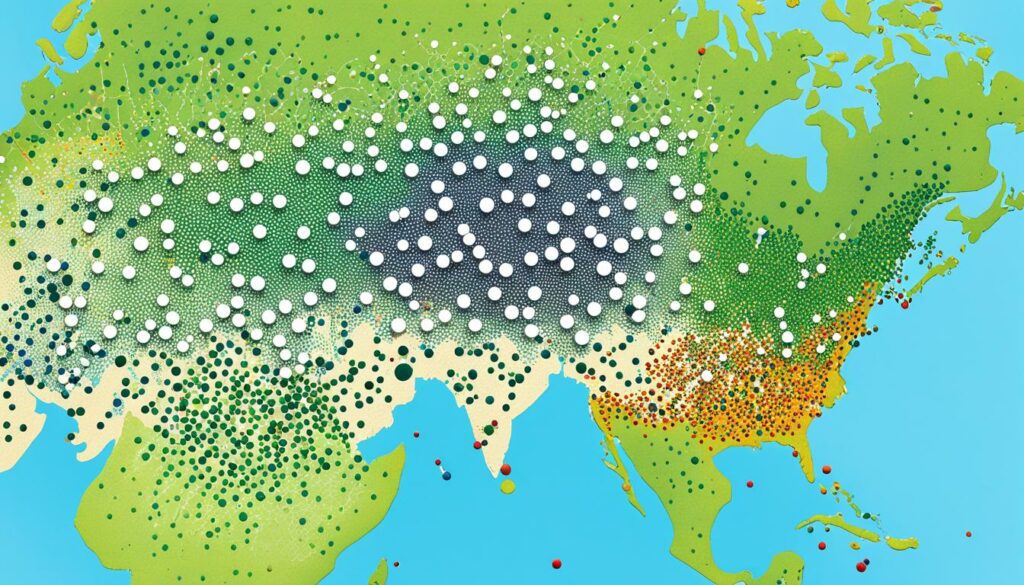
Around the globe, nations are making lists of harmful invasive species. These lists help us track and control plant and animal invaders, which harm local ecosystems. This work supports global conservation goals and helps every country know what dangers to look out for.
Especially since the year 2000, a lot of data comes from people working together worldwide. This gathering is big news for keeping track of what’s going on in natural areas. It helps with planning actions to protect our environment, both near home and far away.
Big groups like the Global Biodiversity Information Facility (GBIF) and GEO BON are expanding across the planet. They bring together lots of information from many sources. This joint effort makes it easier for us to watch, learn, and protect our natural world.
Most data from the GBIF about protected areas comes from people watching locally. This work is seen in three quarters of these areas. Even countries with fewer resources benefit a lot from this shared knowledge.
| Statistical Highlights | Percentage |
|---|---|
| Participatory Monitoring Data since 2000 | 77% |
| Exclusive GBIF Data Source for Protected Areas | 25% |
| Contribution in Majority of Protected Areas | 75% |
| Contribution in Nearly All Protected Areas | 59% |
The amount of information people contribute is going up, covering more and more types of plants and animals. While this is good news, we need to do more to protect those creatures who are at risk around the world.
Between 2020 to 2023, more than 850 people joined the WildLIVE! project. They gave nearly 9,000 hours of their time for free. This shows how much citizen science initiatives can help in saving our planet. By getting the community involved, the WildLIVE! project was able to collect more data. This helped in doing better research and answering big questions about conservation.
The WildLIVE! team set up 25 camera traps in Bolivia’s Chiquitano Dry Forest (CDF). These traps cover about 23,025 hectares. They were designed to get better images of jaguars and other animals. This work shows how important it is to include the public in monitoring wildlife. It makes monitoring on a large scale possible.
In 2019, a wildfire damaged 12% of the CDF forests. After that, it became clear we needed better ways to watch over the forests. Data from the camera traps between January 2017 and December 2021 helped create a biodiversity index. This index helps in making smarter choices for protecting the forest. Citizen science initiatives, along with expert checks and AI, help a lot in these projects.
It’s key to check that data from citizen scientists is correct. The WildLIVE! project joins old and new ways to make sure data is good. This shows how community-based monitoring helps research. It also gets the public more involved in protecting nature.
People can use apps like eBird and iNaturalist to share data easily. These apps make collecting information simple for anyone. They help all data collectors work together better. This adds more data to the world’s ecological archives.
Working together through citizen science initiatives helps everyone take on big environmental problems. It brings scientists and the public closer. This teamwork is crucial for long-lasting efforts in conservation.
Our planet’s biodiversity is facing huge threats today. Many species are vanishing fast. We’ve not seen this extinction speed for the past 60 million years. Nearly 1 million species are at risk. Since the 1970s, wildlife numbers have dropped by about 68%. This highlights how urgent innovative ecological monitoring is.
Old ways of monitoring biodiversity are accurate but slow and costly. Thankfully, new technologies are making things easier and cheaper. Digital tools like remote sensing are changing the game. These tools include remote sensing by using optical, radar, and lidar technology. Galago, for instance, offers a cost-effective, comprehensive solution. It includes high-res images, 3D models, and AI for change detection. And it’s easy to use.
Various sources, from archaeology to citizen science, are helping in conservation work. Citizen science, especially, plays a big role. It gets more people involved in monitoring biodiversity. It helps fill data gaps. By combining new tools and involving volunteers, we’re in a better position. This helps us meet goals to protect biodiversity worldwide.
To sum up, advanced tools and global teamwork are key in saving biodiversity. Modern tech and methods are crucial. Using them, scientists, policymakers, and people worldwide can work together. This way, our efforts to save the planet are smarter, more accurate, and serve future generations well.
Biodiversity monitoring tools are a mix of instruments and techniques. They check the status of biological diversity in different areas. These tools include things like ecological monitors, devices for nature observation, and gadgets for conservation data.
Watching biodiversity helps us spot changes. It shows us how healthy ecosystems are. This info is key for saving biodiversity and helping nature help people.
EBVs are basic but crucial information for spotting environmental issues. They help in looking at, reporting on, and managing these problems. They are a big part of global efforts to save biodiversity and stick to international policies.
The biggest hurdle is organising a global check on invasive foreign species. These species can badly hurt the environment and the economy. We need strong and long-lasting monitoring systems to tackle this problem.
Monitoring soil health looks at soil’s biology, chemistry, and structure. It shows us if the soil can support life and ecosystem services. This is crucial in understanding how well ecosystems can perform and adapt.
New tech, like remote sensing and tools for identifying species, has changed how we watch wildlife. They let us monitor large areas and pinpoint species precisely. This is essential for saving animals and habitats.
Citizen science is when the public helps in scientific studies, including monitoring biodiversity. This gets more people involved, raises awareness, and helps collect more data from different places.
Combining biodiversity and soil health info gives us a full picture of how ecosystems work. Tools like the Biodiversity & Soil Health Metrics Tool allow us to see ecological results clearly. This helps us manage to save both soil and biodiversity better.
These devices include automatic recorders, camera traps, and sound recorders. They collect data without disturbing wildlife. This data helps us learn more about animals and their numbers.